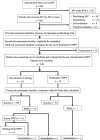A comprehensive protocol for ventilator weaning and extubation: a prospective observational study
- PMID: 31719990
- PMCID: PMC6833251
- DOI: 10.1186/s40560-019-0402-4
A comprehensive protocol for ventilator weaning and extubation: a prospective observational study
Abstract
Background: Ventilator weaning protocols have been shown to reduce the duration of mechanical ventilation (MV), intensive care unit length of stay, and resource use. However, weaning protocols have not significantly affected mortality or reintubation rates. The extubation process is a critical component of respiratory care in patients who receive MV. Post-extubation respiratory failure (PERF) is a common event associated with significant morbidity and mortality. We hypothesized that a comprehensive protocol for ventilator weaning and extubation would be effective for preventing PERF and reintubation and reducing mortality in critically ill patients.
Methods: A ventilator weaning and extubation protocol was developed. The protocol consisted of checklists across four evaluations: spontaneous breathing trial, extubation, prophylactic non-invasive positive pressure ventilation (NPPV), and evaluation after extubation. Observational data were collected after implementing the protocol in patients admitted to the Advanced Emergency and Critical Care Center of Shinshu University Hospital. Not only outcomes of patients but also influences of each component of the protocol on the clinical decision-making process were investigated. Further, a comparison between PERF and non-PERF patients was performed.
Results: A total of 464 consecutive patients received MV for more than 48 h, and 248 (77 women; mean age, 65 ± 17 years) were deemed eligible. The overall PERF and reintubation rates were 9.7% and 5.2%, respectively. Overall, 54.1% of patients with PERF received reintubation. Hospital stay and mortality were not significantly different between PERF and non-PERF patients (p = 0.16 and 0.057, respectively). As a result, the 28-day and hospital mortality were 1.2% and 6.9%, respectively.
Conclusions: We found that the rates of PERF, reintubation, and hospital mortality were lower than those in previous reports even with nearly the same degree of severity at extubation. The comprehensive protocol for ventilator weaning and extubation may prevent PERF and reintubation and reduce mortality in critically ill patients.
Keywords: Comprehensive protocol for ventilator weaning and extubation; Hospital mortality; Post-extubation respiratory failure; Reintubation.
© The Author(s). 2019.
Conflict of interest statement
Competing interestsThe authors declare that they have no competing interests.
Figures



Comment in
-
Strategies for Liberation from Mechanical Ventilation.Am J Respir Crit Care Med. 2021 May 1;203(9):1183-1185. doi: 10.1164/rccm.202006-2312RR. Am J Respir Crit Care Med. 2021. PMID: 33631088 No abstract available.
References
-
- Navalesi P, Frigerio P, Moretti MP, Sommariva M, Vesconi S, Baiardi P, Levati A. Rate of reintubation in mechanically ventilated neurosurgical and neurologic patients: evaluation of a systematic approach to weaning and extubation. Crit Care Med. 2008;36:2986–2992. doi: 10.1097/CCM.0b013e31818b35f2. - DOI - PubMed
-
- Tobin MJ, Laghi F. Extubation. In: Tobin MJ, editor. Principles and practice of mechanical ventilation. 2. New York: McGraw-Hill; 2004. pp. 1221–1237.
LinkOut - more resources
Full Text Sources
Research Materials

